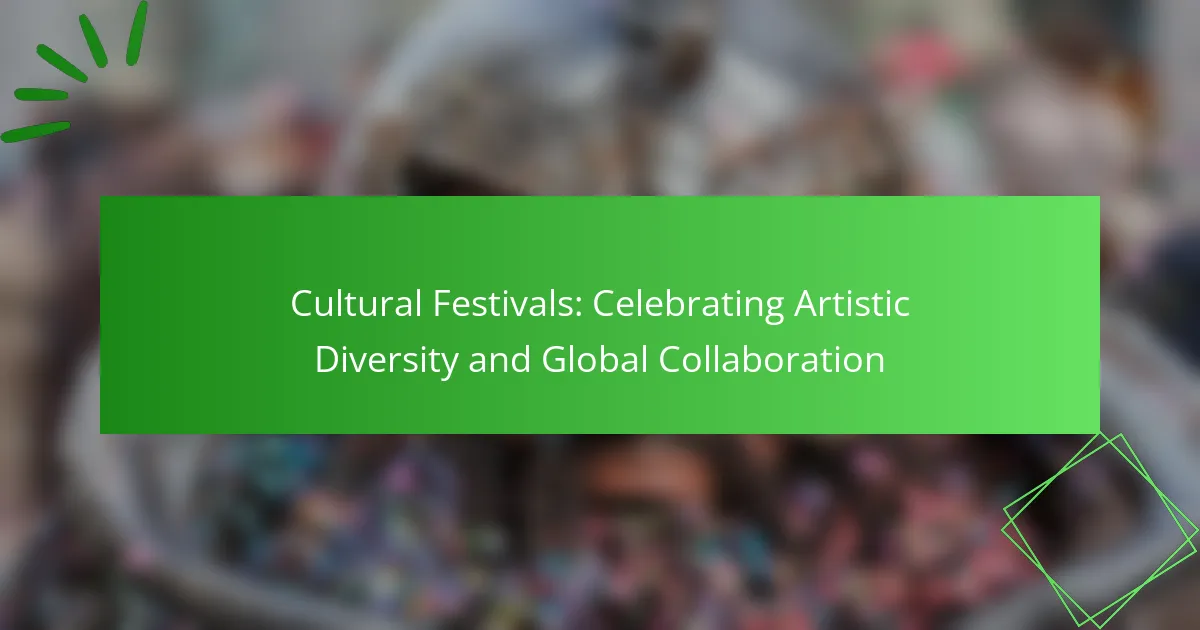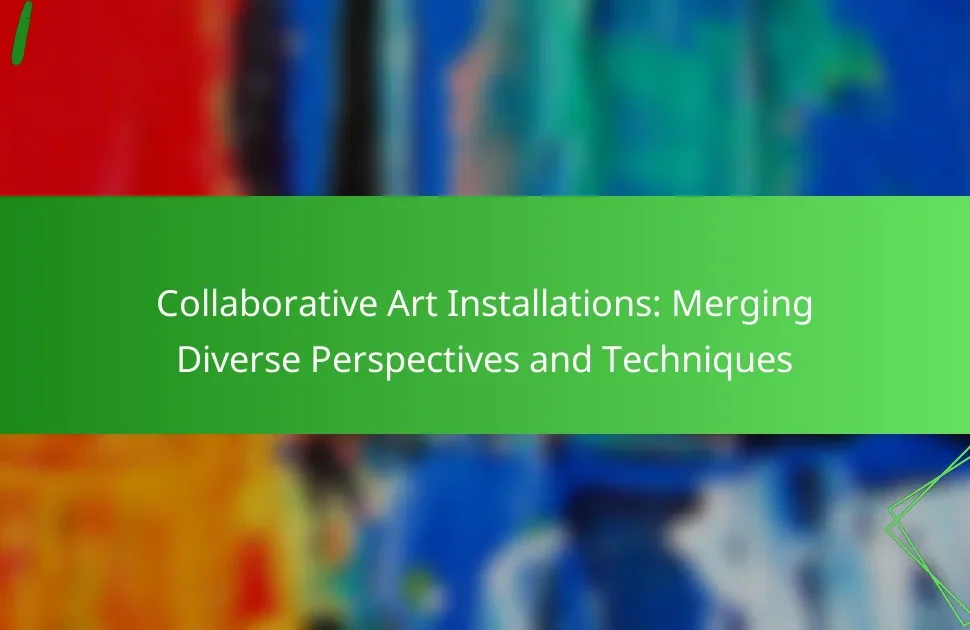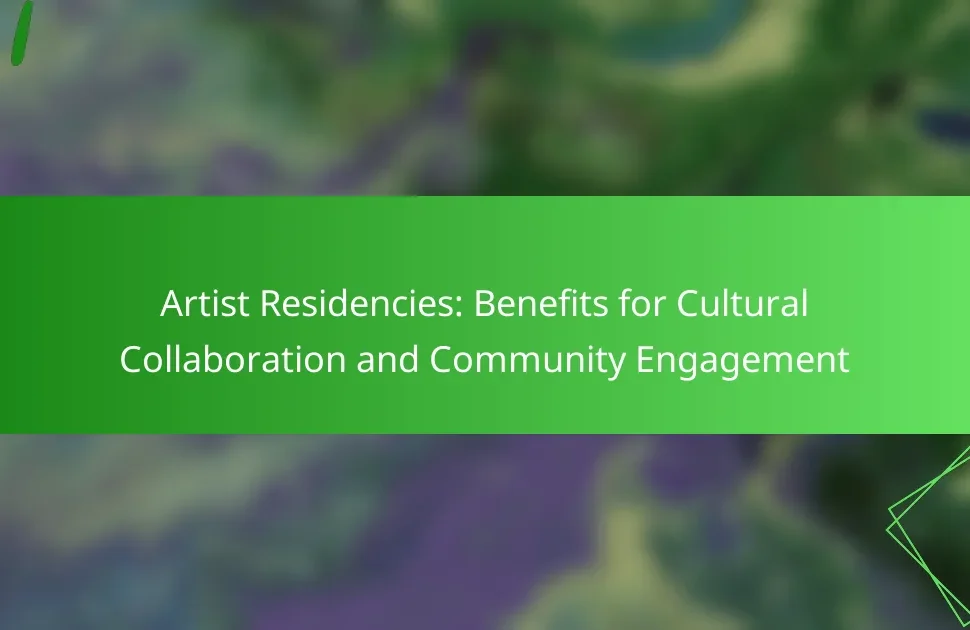Cultural festivals play a crucial role in promoting artistic diversity and fostering global collaboration. They serve as platforms for intercultural exchanges, enhancing community engagement and strengthening social ties. These events also contribute to economic development by attracting tourism and supporting local economies. However, challenges such as commercialization and cultural appropriation threaten the authenticity of these celebrations.
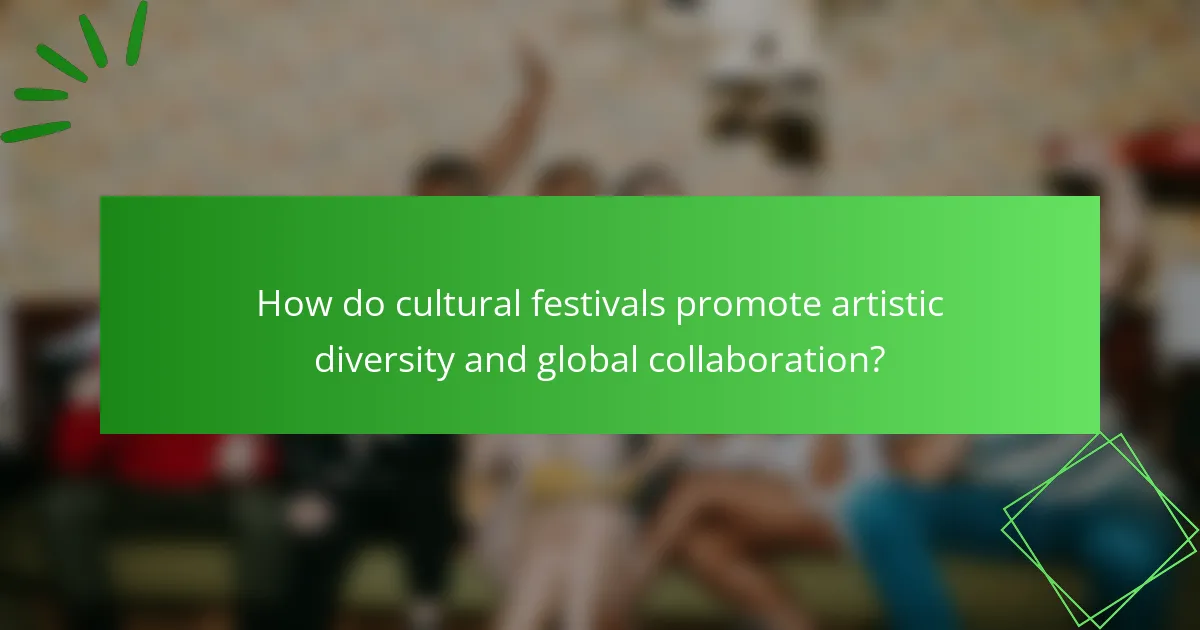
How do cultural festivals promote artistic diversity and global collaboration?
Cultural festivals promote artistic diversity and global collaboration by showcasing various art forms and fostering intercultural exchanges. These events create platforms where artists from different backgrounds collaborate, share ideas, and inspire one another.
Participating in cultural festivals enhances community engagement and strengthens social ties. For instance, festivals often include workshops, performances, and exhibitions that encourage local and international artists to interact. This exchange of creativity leads to unique artistic expressions that reflect a blend of traditions.
Moreover, cultural festivals contribute to economic development by attracting tourism and supporting local economies. They provide opportunities for artists to gain visibility and recognition, which can lead to further collaboration and innovation.
In summary, cultural festivals serve as vital hubs for artistic diversity and global collaboration, enriching communities and fostering understanding through shared experiences.
What are the key components of successful cultural festivals?
Successful cultural festivals hinge on key components such as community engagement, diverse programming, strategic partnerships, and effective marketing. Community involvement fosters a sense of ownership, while diverse programming showcases artistic expressions from various cultures. Strategic partnerships with local businesses enhance resources and visibility. Effective marketing ensures broad outreach, attracting attendees and sponsors alike. These elements collectively contribute to the festival’s vibrancy and sustainability.
Which cultural festivals exemplify collaboration between different artistic forms?
Cultural festivals exemplifying collaboration between different artistic forms include the Edinburgh Festival Fringe, Burning Man, and the Venice Biennale. These events merge theater, music, visual arts, and dance, showcasing diverse cultural expressions.
The Edinburgh Festival Fringe features thousands of performances across genres, promoting cross-disciplinary collaboration. Burning Man fosters creativity through art installations, performances, and community engagement, emphasizing collaboration among participants. The Venice Biennale highlights contemporary art through various mediums, encouraging dialogue between artists from different disciplines.
These festivals create platforms for innovation, enabling artists to explore new forms and ideas. They demonstrate how collaboration enriches cultural experiences and fosters global artistic connections.
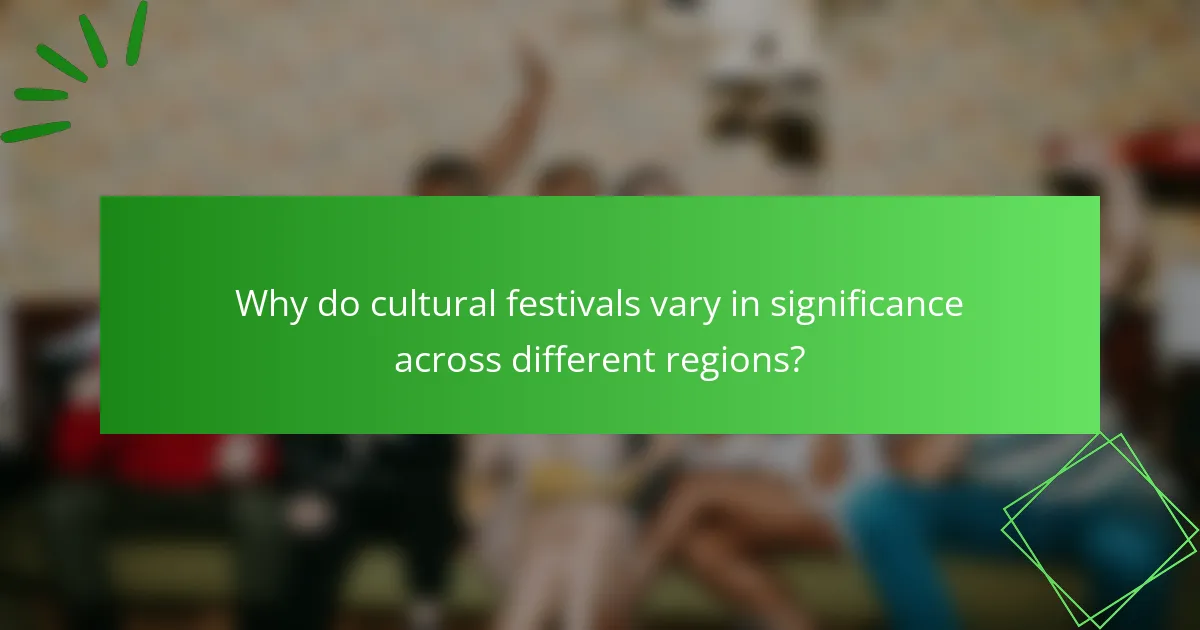
Why do cultural festivals vary in significance across different regions?
Cultural festivals vary in significance across regions due to historical, social, and economic factors. Each region’s unique traditions, beliefs, and values shape the way festivals are celebrated. For example, festivals in rural areas may emphasize agricultural practices, while urban festivals often highlight contemporary art and multicultural influences.
The historical context of a region influences festival themes, such as commemorating past events or honoring local deities. Social dynamics, including community involvement and participation levels, also affect festival significance. Economic factors, like tourism and local business support, can elevate certain festivals’ prominence, making them vital for regional identity and cohesion.
As a result, cultural festivals serve as a reflection of the diverse artistic expressions and collaborative efforts that define different communities. This diversity enriches global culture by fostering understanding and appreciation of varied traditions.
How do local traditions influence the themes of cultural festivals?
Local traditions significantly shape the themes of cultural festivals by reflecting community values and historical narratives. These festivals often showcase unique attributes, such as traditional music, dance, and cuisine, which are rooted in the local culture. For example, the Diwali festival in India emphasizes the theme of light overcoming darkness, deeply tied to Hindu beliefs and practices.
Moreover, local customs influence the festival’s visual elements, including decorations and attire. Each region may present its own rare attributes, such as specific rituals or folklore, that enhance the festival’s authenticity and appeal. As a result, cultural festivals become a platform for global collaboration, allowing diverse communities to share their artistic expressions while preserving their unique identities.
What role do community organizations play in shaping cultural festivals?
Community organizations play a crucial role in shaping cultural festivals by promoting inclusivity and representation. They facilitate collaboration among diverse groups, ensuring that various cultural expressions are showcased. These organizations often coordinate events, engage local artists, and secure funding, enhancing the festival’s reach and impact. Their involvement fosters a sense of community ownership and pride, ultimately enriching the cultural landscape. By encouraging participation from all demographics, they help preserve cultural heritage while promoting artistic diversity.
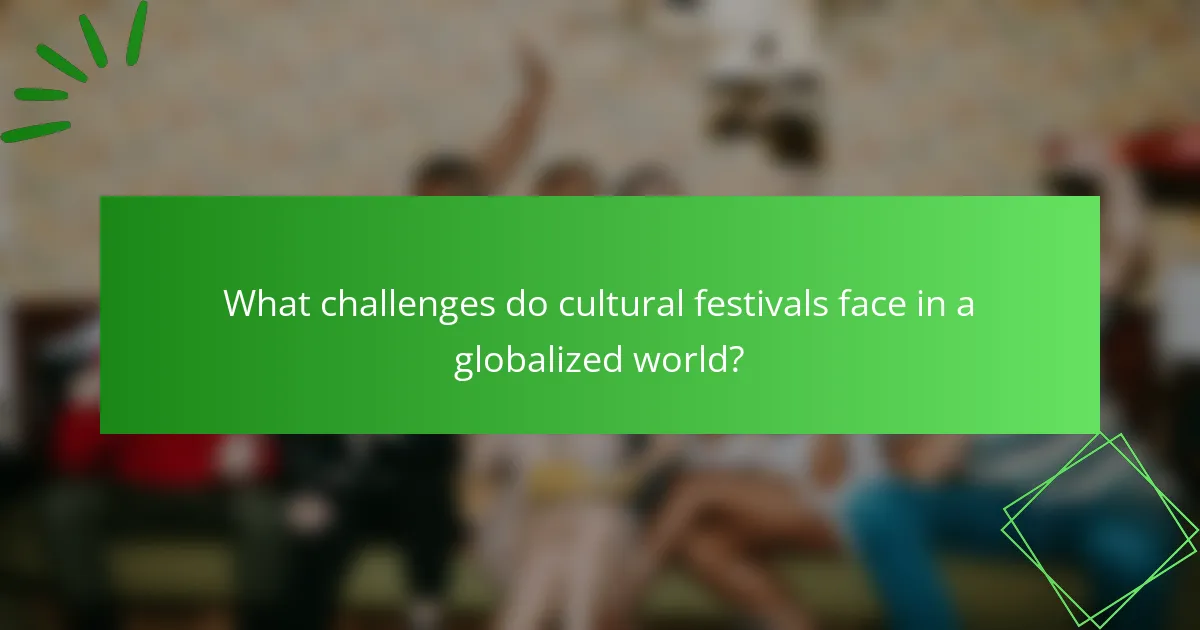
What challenges do cultural festivals face in a globalized world?
Cultural festivals face significant challenges in a globalized world, including commercialization, cultural appropriation, and loss of authenticity. These issues can dilute the original purpose of celebrating artistic diversity.
Commercialization often prioritizes profit over cultural significance, leading to a focus on entertainment rather than genuine cultural expression. For instance, large-scale festivals may cater to mass tourism, altering traditional practices to attract larger crowds.
Cultural appropriation poses another challenge, where elements of a culture are used without understanding or respect. This can result in the misrepresentation of cultural identities, causing frustration among communities.
Additionally, globalization can lead to a homogenization of cultural expressions, where unique local traditions are overshadowed by dominant global trends. This threatens the survival of diverse cultural practices, making it essential for festivals to navigate these complexities while preserving their core values.
How can cultural festivals maintain authenticity while appealing to global audiences?
Cultural festivals can maintain authenticity while attracting global audiences by emphasizing local traditions and engaging community participation. This approach fosters genuine experiences that resonate with visitors. For example, integrating local artists ensures cultural representation and preserves unique heritage. Additionally, using technology can enhance accessibility without compromising authenticity. Festivals that balance these elements create a rich tapestry of cultural exchange, appealing to diverse audiences while honoring their roots.
What are the environmental impacts of large-scale cultural festivals?
Large-scale cultural festivals can significantly impact the environment through resource consumption and waste generation. These events often require substantial energy, water, and land use, leading to habitat disruption.
Transportation emissions from attendees and performers contribute to air pollution. For instance, festivals may attract thousands, increasing vehicle traffic and carbon footprints. Waste management poses another challenge, as large crowds generate considerable waste, often overwhelming local disposal systems.
In some cases, festivals promote sustainability through eco-friendly practices. Initiatives such as recycling programs and renewable energy use can mitigate negative effects. However, the overall environmental footprint remains a concern, necessitating ongoing evaluation and improvement.
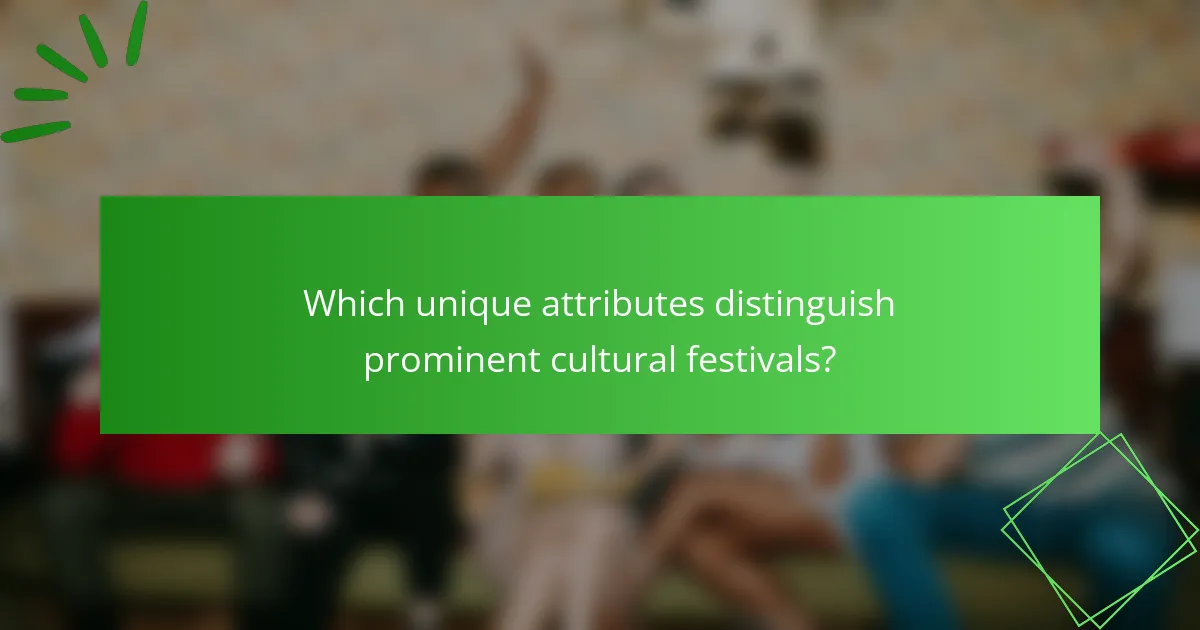
Which unique attributes distinguish prominent cultural festivals?
Prominent cultural festivals are distinguished by their unique themes, traditions, and community involvement. Each festival showcases distinct artistic expressions, reflecting local heritage and global influences. For example, the Carnival in Rio de Janeiro features vibrant parades and samba music, while Diwali in India emphasizes light and family gatherings. Unique attributes include the festival’s historical significance, the specific art forms celebrated, and the geographical diversity of participants. These elements foster collaboration and cultural exchange, enriching the global tapestry of artistic diversity.
How do specific cultural festivals celebrate indigenous art forms?
Cultural festivals celebrate indigenous art forms by showcasing traditional practices and fostering community engagement. These events often feature performances, workshops, and exhibitions that highlight unique cultural expressions. For instance, festivals like the Smithsonian Folklife Festival promote the art of indigenous crafts, music, and dance, allowing artists to share their heritage. Such celebrations not only preserve these art forms but also encourage global collaboration and understanding. Additionally, festivals often include storytelling sessions, which serve as a vehicle for cultural transmission and education.
What innovative technologies are being utilized in modern cultural festivals?
Modern cultural festivals utilize innovative technologies such as augmented reality, live streaming, and interactive installations to enhance visitor experiences. These technologies foster engagement and promote artistic diversity. For example, augmented reality allows attendees to interact with art pieces in immersive ways, while live streaming expands access to global audiences. Interactive installations encourage collaboration among artists and attendees, creating a dynamic cultural exchange. Drones are also used for aerial photography and to deliver performances, showcasing the festival’s scale and creativity.
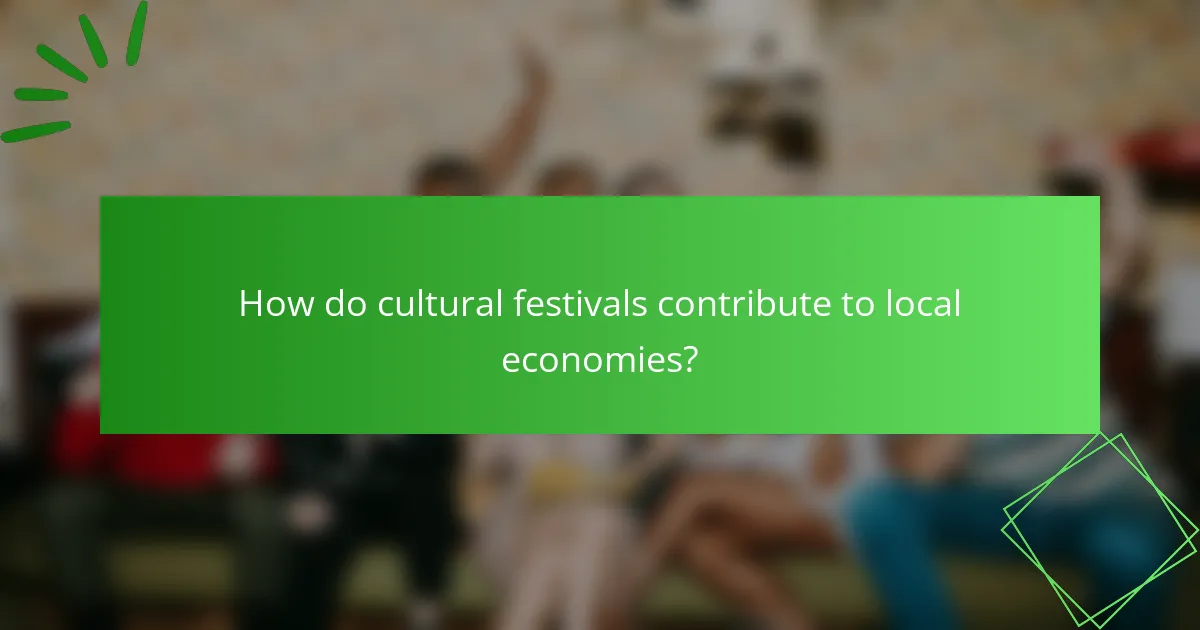
How do cultural festivals contribute to local economies?
Cultural festivals significantly boost local economies by attracting tourists and generating revenue. They create jobs, stimulate local businesses, and enhance community pride. Festivals often lead to increased spending in hospitality, retail, and entertainment sectors. For instance, a study showed that festivals can contribute millions in revenue, enhancing infrastructure and services. Additionally, they promote cultural exchange and community engagement, fostering long-term economic benefits.
What metrics are used to measure the economic impact of cultural festivals?
Cultural festivals are measured by various economic impact metrics. Key metrics include direct spending, job creation, tax revenues, and tourism growth.
Direct spending quantifies the money spent by attendees on accommodations, food, and activities. Job creation reflects the number of new positions generated in local businesses. Tax revenues assess the increase in local and state taxes due to festival-related activities. Tourism growth measures the rise in visitors attracted by the festival, contributing to the local economy.
These metrics collectively illustrate the economic significance of cultural festivals, showcasing their role in community development and cultural exchange.
How do cultural festivals create job opportunities in their communities?
Cultural festivals create job opportunities by boosting local economies and attracting tourism. These events require staffing for various roles, including event management, hospitality, and entertainment.
Festivals often hire local artisans, vendors, and performers, promoting cultural exchange and supporting small businesses. For instance, a festival may employ up to 200 temporary workers, significantly impacting community employment rates.
Additionally, festivals can lead to infrastructure improvements, such as better transportation and public spaces, further enhancing job prospects. As a result, communities that host cultural festivals often experience long-term economic growth and increased job stability.
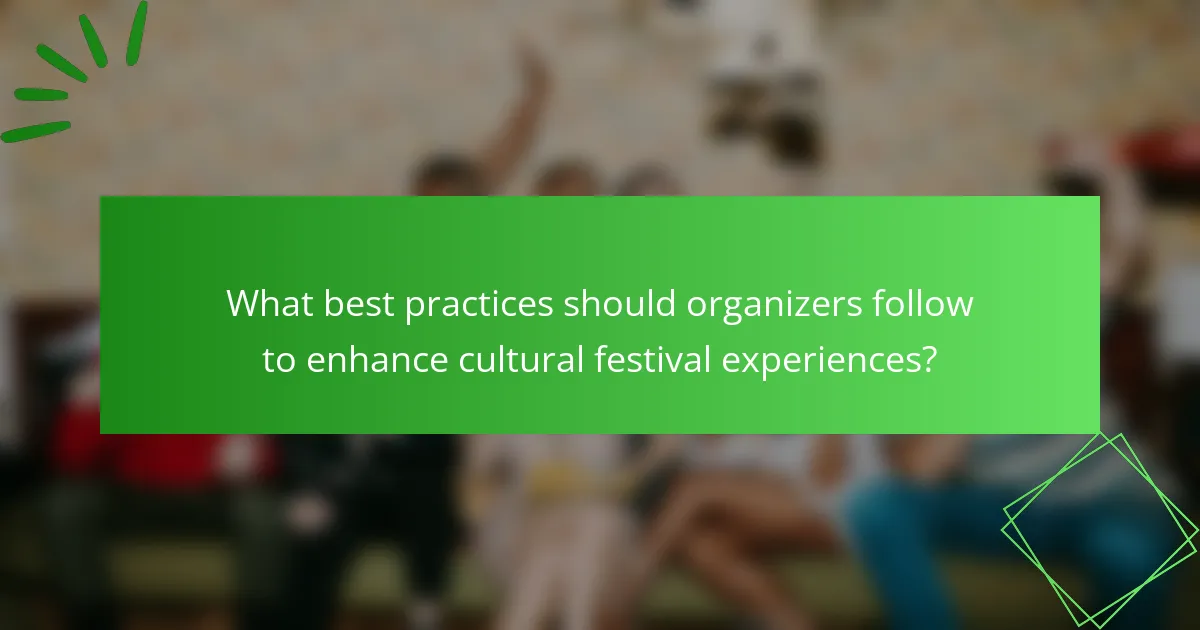
What best practices should organizers follow to enhance cultural festival experiences?
Organizers should prioritize community engagement, diverse programming, and accessibility to enhance cultural festival experiences. Fostering local participation strengthens connections and promotes inclusivity. Offering varied artistic expressions caters to a broader audience, enriching the experience. Ensuring accessibility allows all individuals to partake, creating a welcoming environment.
How can festival organizers effectively engage with diverse audiences?
Festival organizers can engage diverse audiences by incorporating inclusive programming, utilizing targeted marketing strategies, and fostering community partnerships.
Inclusive programming ensures representation of various cultures through performances, workshops, and exhibitions. This approach highlights unique attributes of each culture, enhancing audience connection. Targeted marketing reaches different demographics via tailored messaging across social media and local channels. This strategy increases visibility and attracts a broader audience. Community partnerships with local organizations enhance credibility and provide insights into audience preferences, ensuring the festival resonates with attendees.
By focusing on these engagement strategies, festival organizers can create a rich, diverse atmosphere that celebrates artistic diversity and fosters global collaboration.
What common mistakes should be avoided in planning cultural festivals?
To plan cultural festivals effectively, avoid common mistakes that can undermine their success.
Neglecting community involvement can lead to a lack of engagement. Failing to set a clear budget often results in overspending or insufficient resources. Ignoring cultural sensitivity may alienate participants and attendees. Underestimating logistical challenges can create operational issues. Lastly, overlooking marketing strategies can limit audience reach and participation.
